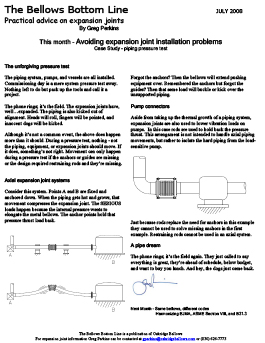Avoiding Expansion Joint Installation Problems

The piping system, pumps, and vessels are all installed. Commissioning day is a mere system pressure test away. Nothing left to do but pack up the tools and call it a project.
The phone rings; it’s the field. The expansion joints have, well…expanded. The piping is also kicked out of alignment. Heads will roll, fingers will be pointed, and innocent dogs will be kicked.
Although it’s not a common event, the above does happen more than it should. During a pressure test, nothing – not the piping, equipment, or expansion joints should move. If it does, something’s not right. Movement can only happen during a pressure test if the anchors or guides are missing or the design required restraining rods and they’re missing.
Axial expansion joint systems
Consider this system. Points A and B are fixed and anchored down. When the piping gets hot and grows, that movement compresses the expansion joint. The SERIOUS loads happen because the internal pressure wants to elongate the metal bellows. The anchor points hold that pressure thrust load back.
Forgot the anchors? Then the bellows will extend pushing equipment over. Remembered the anchors but forgot the guides? Then that same load will buckle or kick over the unsupported piping.
Pump connectors
Aside from taking up the thermal growth of a piping system, expansion joints are also used to lower vibration loads on pumps. In this case rods are used to hold back the pressure thrust. This arrangement is not intended to handle axial piping movements, but rather to isolate the hard piping from the load-sensitive pump.
Just because rods replace the need for anchors in this example they cannot be used to solve missing anchors in the first example. Restraining rods cannot be used in an axial system.
A pipe dream
The phone rings; it’s the field again. They just called to say everything is great, they’re ahead of schedule, below budget, and want to buy you lunch. And hey, the dogs just came back.


